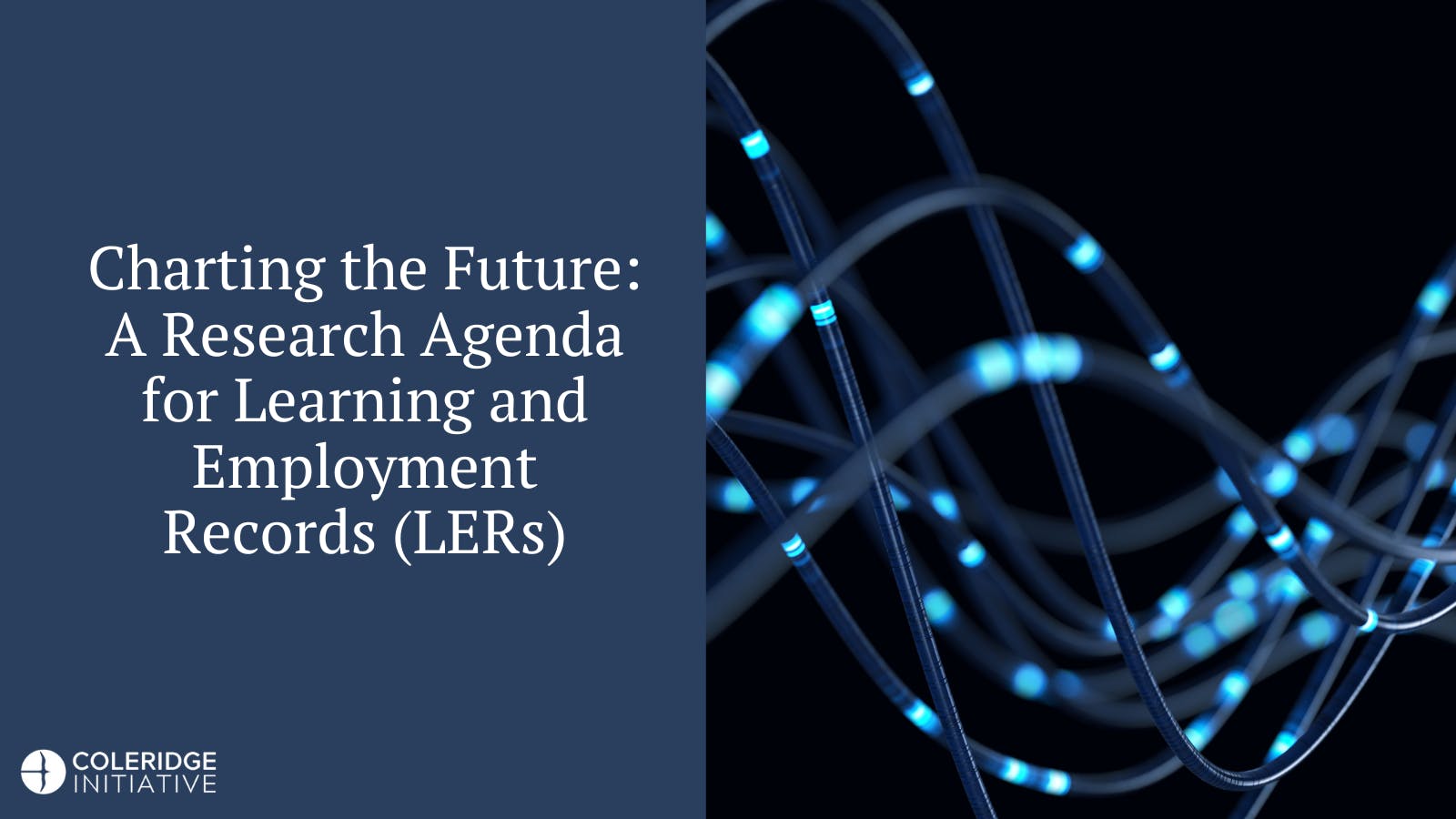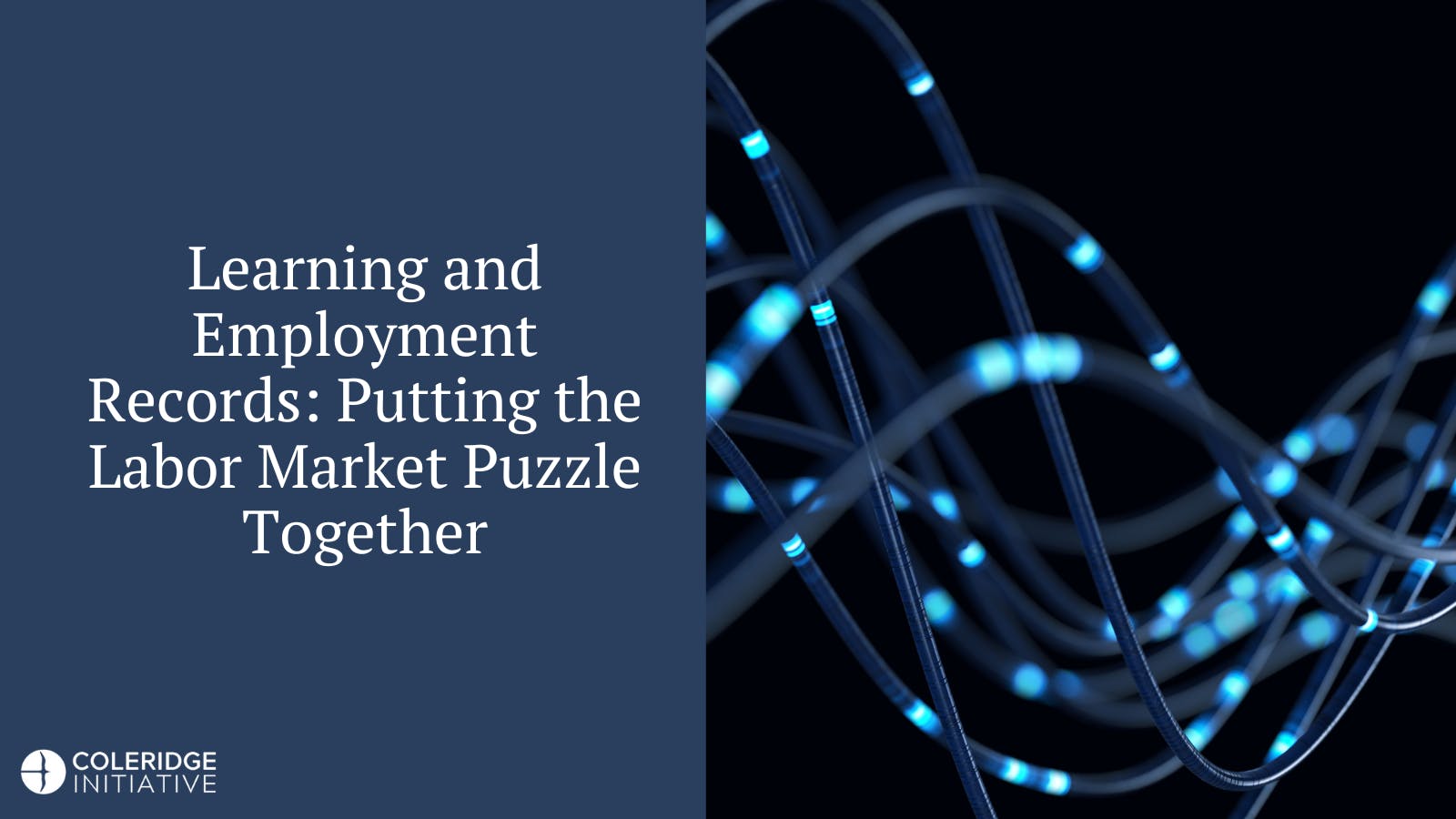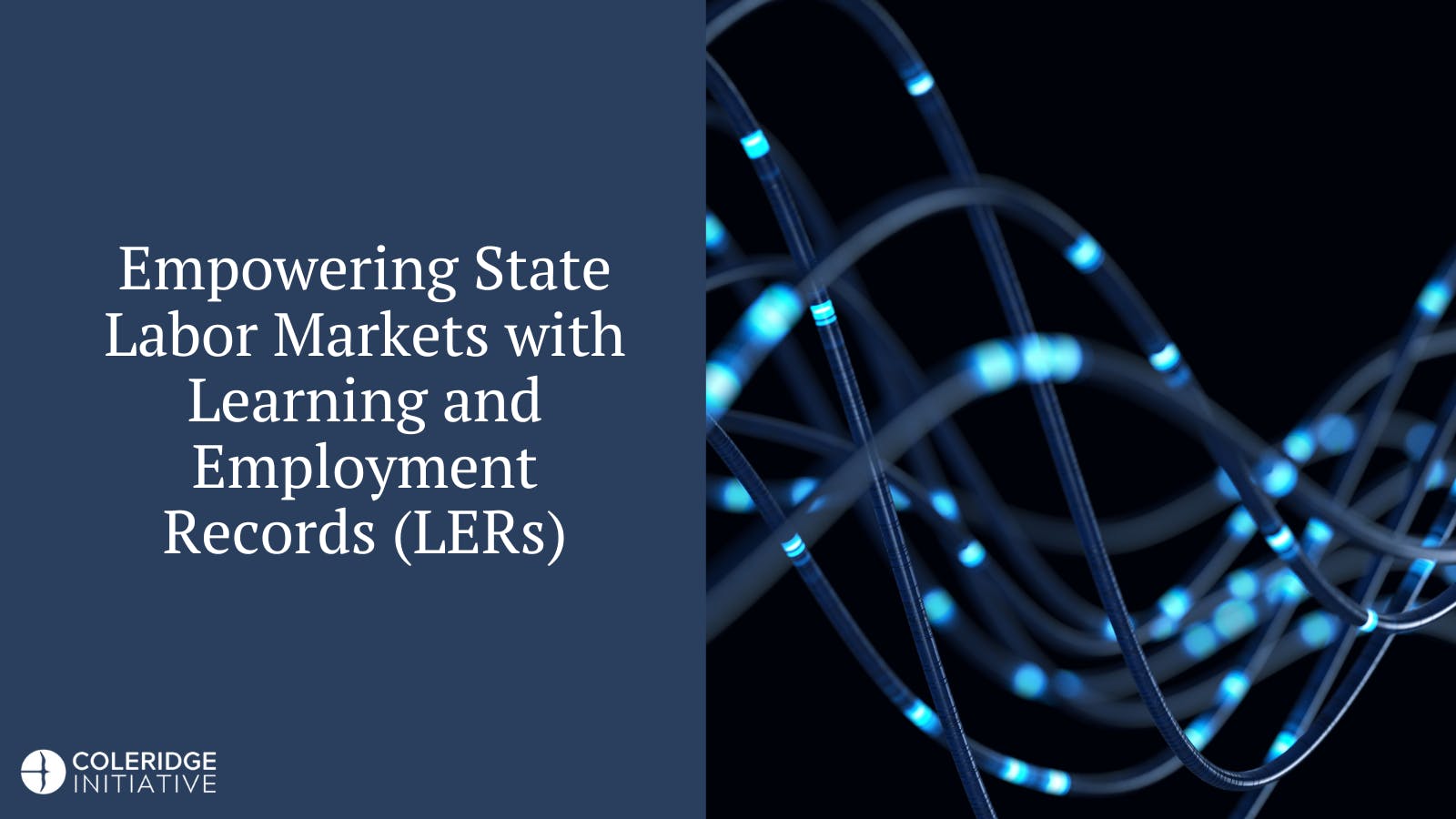Insights

16 Apr 2024
Charting the Future: A Research Agenda for Learning and Employment Records (LERs)
By: Nathan Barrett, Ph.D., Vice President of Product and Development, Coleridge Initiative
Introduction As the workforce evolves alongside rapid technological advancements, Learning and Employment Records (LERs) have emerged as pivotal tools for advancing skills-based hiring practices. This blog outlines a focused research agenda in three key themes to explore how LERs can transform not just individual careers but also organizational practices and the broader economy. These themes are not exhaustive, but rather focus more on the use and implementation of LERs rather than other key issues such as privacy, data infrastructure, and governance. We discuss these subjects in more detail in our recent white paper “Bridging Gaps in the Labor Market: The Role of Learning and Employment Records and the Data Infrastructure Needed to Support Them”. Implementation within Organizations: Process, Skill Prioritization, and Organizational Fit Organizations face unique challenges in implementing LERs, which makes it essential to study the processes they employ to integrate these systems into their existing human resource frameworks. Key research questions include: Process Efficiency: How do organizations integrate LERs with their existing HR systems? What processes are most effective for adopting LERs at different scales within various industries? Skill Prioritization: How do organizations use LERs to identify and prioritize the skills needed in their workforce? What criteria do they use to update and adapt these priorities as market conditions change? Are both technical and people skills utilized in organizational use of LERs? Organizational Fit: How do LERs influence the alignment of individual skills with organizational needs? What strategies do organizations use to match LER profiles with job roles to optimize team composition, productivity, and overall organizational fit? This research will uncover best practices and highlight potential challenges in organizational LER integration, offering a blueprint for effective implementation. Broad Labor Market Implementation: Sector Differences, Feedback Loops, and Equity LERs have the potential to transform the labor market on a macro scale, necessitating research into their broad-based implementation across different sectors and demographic groups. Important areas of focus include: Sector Differences: How does LER implementation vary across different sectors such as technology, healthcare, and manufacturing? What sector-specific challenges and opportunities do LERs present? Feedback Loops: What mechanisms are effective for creating continuous feedback loops between employers, educational institutions, and workforce training programs that communicate evolving workforce needs? How can LERs be used to optimize feedback loops to enhance the relevance and responsiveness of education and training programs? Equity Concerns: How do LERs impact employment equity across different groups, including underrepresented populations? What approaches can be implemented to ensure that LERs promote inclusivity and diversity? Exploring these questions will help tailor LER strategies to diverse labor market needs and ensure they serve as tools for equity and inclusivity. Economic Impact: Frictional and Structural Unemployment and Economic Efficiency The adoption of LERs can affect the economy by potentially reducing both frictional and structural unemployment. This research theme is critical for understanding the broader economic impacts of LERs: Frictional Unemployment: Can LERs reduce the time individuals spend between jobs by providing better skill matches quickly and efficiently? What role do LERs play in smoothing transitions in career changes or geographic moves? Structural Unemployment: How effective are LERs in addressing mismatches between available skills and job requirements? Can they help forecast and mitigate the impacts of automation and other technological changes on workforce displacement? Economic Modeling: What are the broader economic implications of widespread LER adoption? How do LERs influence labor market dynamics, productivity, and economic growth? Addressing these questions will provide insights into how LERs can contribute to a more dynamic and resilient economy, helping policymakers and business leaders make informed decisions. Conclusion As LERs continue to gain traction, it is imperative to ground their expansion in rigorous research that addresses these three themes. By exploring how LERs are implemented within organizations, across the broader labor market, and their effects on the economy, stakeholders can maximize the benefits of LERs while mitigating potential risks. This research agenda sets the stage for a comprehensive understanding of LERs as transformative tools in the modern labor market, ensuring they are used effectively to enhance both individual careers and economic outcomes. Call to Action As the LER landscape evolves so too will the opportunities to better understand their use and broader impacts. Accordingly, we invite researchers, practitioners, policymakers, and educators to engage with this agenda, contributing to a body of knowledge that will shape the future of work. Your insights and expertise are crucial in harnessing the full potential of Learning and Employment Records for a better, more equitable labor market. Read the White Paper: Bridging Gaps in the Labor Market: The Role of Learning and Employment Records and the Data Infrastructure Needed to Support Them.

13 Mar 2024
Learning and Employment Records: Putting the Labor Market Puzzle Together
By: Nathan Barrett, Ph.D., Vice President of Product and Development, Coleridge Initiative
Imagine the labor market as a vast, dynamic puzzle where each piece represents an individual worker, each with unique skills and experiences suitable for various industries and roles. The puzzle board represents the economy, with various sections depicting different industries and sectors. The goal is to fit each piece into the right place, ensuring a perfect match that contributes to the complete picture of a thriving, efficient economy. However, three main challenges make this task difficult: structural unemployment, frictional unemployment, and asymmetric information. Learning and Employment Records (LERs) act as a powerful tool to address these challenges, helping to piece together the labor market puzzle more effectively. Frictional unemployment is like having all the right pieces but struggling to place them quickly because workers are transitioning between jobs or locations, and it's not immediately clear where they fit best. LERs can act as a guide, providing a clear overview of each piece's shape and color. They help both workers and employers see where each piece fits best, reducing the time and uncertainty involved in finding the right spot. By enhancing job matching and providing up-to-date information on available positions and worker skills, LERs reduce the time each piece spends in limbo, helping to assemble the puzzle more efficiently. Structural unemployment is like missing pieces from a new puzzle and trying to fit pieces from an old puzzle into it. Because the economy has evolved, skills are now outdated and do not match the needs of the current economy. LERs can act as a transformative tool that reshapes these pieces. They identify the gaps between the worker's current skills and the market's needs, guiding targeted reskilling or upskilling programs. As individuals acquire new skills, their puzzle piece is reshaped, allowing them to fit into the evolving economy. LERs can help ensure that no piece is left behind, and everyone has the opportunity to adapt and find their place in the new picture. Asymmetric information is like trying to complete a puzzle in the dark, where employers and workers cannot fully see or understand each other's pieces. This lack of visibility leads to mismatches and inefficiencies. LERs can illuminate the space, revealing the detailed features of each puzzle piece. They provide comprehensive and verified information about workers' skills, experiences, and qualifications, while also giving workers insights into the specific needs and expectations of employers. This enhanced transparency ensures that each piece is placed with a clear understanding of how it fits into the broader picture, reducing mismatches and enhancing overall efficiency. In the complex puzzle of the labor market, LERs can serve as an essential tool, helping to reshape, guide, and illuminate the pieces so that they fit together more seamlessly. By addressing the challenges of structural unemployment, frictional unemployment, and asymmetric information, LERs contribute to a more efficient and complete picture, where every worker finds their place and every employer benefits from the right talent. As the puzzle continues to evolve with the economy, LERs can ensure that the labor market can adapt and thrive, no matter how the picture changes. While a potentially useful analogy, the development and use of a strong LER ecosystem as a solution to the complex puzzle of the labor market is not without challenges. The preceding section takes LERs in their best light and assumes away many potential barriers to their success. Many in this space are leading the way from theory to practice and navigating these challenges. As we continue to move forward, one key opportunity is how to best leverage a robust data system to support an LER ecosystem. We discuss this in more detail in our recent white paper “Bridging Gaps in the Labor Market: The Role of Learning and Employment Records and the Data Infrastructure Needed to Support Them”. Read the White Paper: Bridging Gaps in the Labor Market: The Role of Learning and Employment Records and the Data Infrastructure Needed to Support Them.

06 Mar 2024
Empowering State Labor Markets with Learning and Employment Records (LERs)
By: Nathan Barrett, Ph.D., Vice President of Product and Development, Coleridge Initiative
In the rapidly evolving labor market, states face the dual challenge of adapting to technological advancements and meeting the dynamic needs of employers and job seekers. Traditional methods of documenting and communicating an individual's skills and experiences, such as resumes and transcripts, are proving inadequate. Learning and Employment Records (LERs) offer a promising solution to these challenges. This blog delves into the benefits and challenges associated with implementing LERs, with a focus on the pivotal role of state administrative data. The Promise of LERs LERs are digital records that provide a comprehensive and verifiable account of an individual's educational achievements, skills, work history, and experiences. They are designed to be accessible, portable, and capable of capturing a wide array of learning and work-related experiences. The LER ecosystem, defined by robust data systems and the collection of skills at the individual, industry, and macro labor market levels, gives better insight into the demand and supply of skills. The shift towards a more skills-based approach to job matching addresses common labor market challenges such as frictional and structural unemployment, mismatching, underemployment, and asymmetric information. Benefits to States Enhanced Job Matching: LERs can significantly improve the efficiency of job matching by providing employers with precise and reliable information about job seekers' skills and experiences. This leads to better employment outcomes and a more dynamic labor market. Economic Efficiency: By facilitating a more transparent and responsive job market, LERs contribute to overall economic efficiency. They enable individuals to better understand and navigate the labor market, pursuing education and skills development opportunities that align with market demands. LERs can help shift the narrative from job creation to career creation. Utilization of State Administrative Data: States have made significant investments in building and maintaining comprehensive data systems. The LER ecosystem can leverage this existing infrastructure, enhancing the accuracy, reliability, and depth of the records. This not only maximizes the use of state resources but also supports the development of a more informed and adaptable workforce. Challenges for States Data Privacy and Security: Implementing LERs requires careful consideration of data privacy, consent, compliance, and security. States must develop robust solutions to ensure that the use of administrative data respects individual rights and adheres to legal and ethical standards. Standardization and Interoperability: To effectively integrate administrative data from various sources into LERs, states face the challenge of standardizing data formats and ensuring interoperability among different systems. Data Enhancement: States must also consider how to enhance their administrative data to support the specific needs of LERs. This includes identifying and documenting skills in both education and workforce data, which may require adjustments to data collection and reporting practices. Moving Forward: Recommendations for States To overcome these challenges and fully realize the benefits of LERs, states should consider the following recommendations: Develop Strong Governance Frameworks: Establish robust governance frameworks and data rights legislation to support the effective use of LERs. This includes creating mechanisms for continuous feedback between educators and employers to ensure that educational programs remain aligned with labor market needs. Adopt Technical Solutions: Implement technical solutions that adhere to data privacy and security requirements, incorporate identity resolution protocols, and ensure data quality. This will facilitate the efficient and secure integration of state administrative data into LERs. Foster Collaboration: Encourage collaboration between government agencies, educational institutions, employers, and technology providers to address common challenges and share best practices for implementing LERs. Engage in Continuous Research and Evaluation: Support research and evaluation efforts to assess the impact of LERs on the labor market and identify opportunities for improvement. This includes exploring innovative approaches to data linkage, skills identification, and system optimization. LERs offer a transformative solution to many of the challenges facing state labor markets. By leveraging existing state administrative data and addressing key implementation challenges, states can enhance job matching, improve economic efficiency, and support the continuous development of the workforce. The journey toward implementing LERs will require collaboration, innovation, and a commitment to addressing the needs of all labor market participants. Read the White Paper: Bridging Gaps in the Labor Market: The Role of Learning and Employment Records and the Data Infrastructure Needed to Support Them.